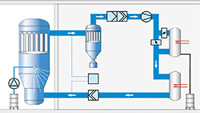|
|
Organic solvents with their specific advantages continue to find wide usage.
Whether alcohol, acetone or methylene chloride.
The protection of the
environment demands that the emissions from process plant be drastically reduced
by the implementation of appropriate systems.
|
|
|
 |
Minimal emissions.
Performs better than current legal requirements.
Circulation principle.
For all
fluid bed and coating systems.
Vacuum principle.
Ideal for vertical
granulators.
|
| |
|
| |
Circulation principle
With a circulating system, the solvents are condensed out, the process gas is
super-heated and fed back into the system.
The principle can be combined with
all systems and processes and offers a range of advantages:
Recovery of solvents
by condensation for re-use or
disposal
Universal application
for all common solvents
High level of safety
due to the whole system being made inert with
N2
|
|
|
Examples of Glatt fluid bed systems with circulation for solvent recovery
|
|
|
Vacuum principle
Here, the process system is evacuated by means of a vacuum pump to a working
pressure below the LEL (Lower Explosion Limit). The vacuum pump sucks out the
solvent gases and feeds them via a condenser on the suction and pressure side.
Due to the absence of the inert gas, there is an excellent heat transfer and
thus an extremely effective recovery. In summary:
Recovery of solvents
by condensation under vacuum
Universal application
with all common solvents
High level of safety
operation below the LEL
Highly effective
due to the absence of inert gases |
| |
|